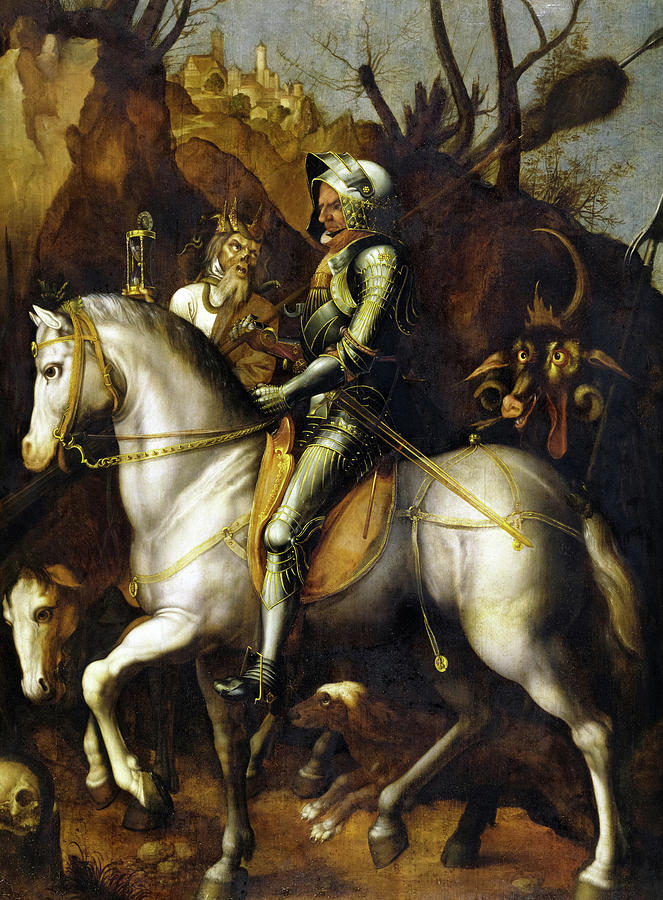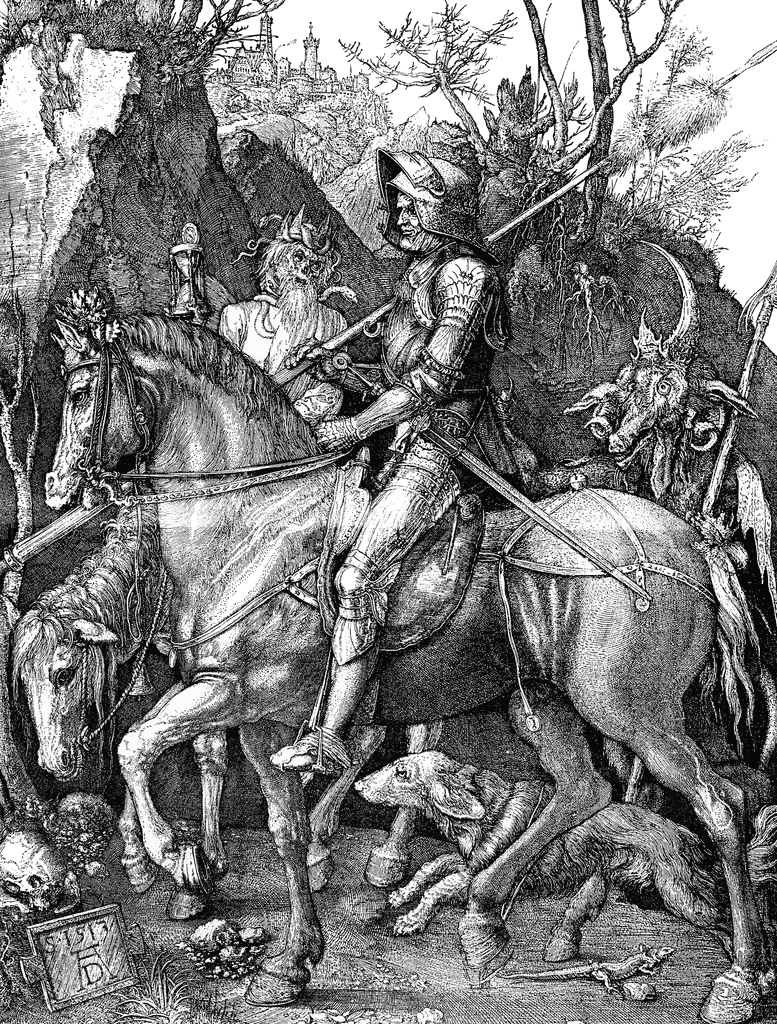Exploring Drer's "Knight, Death, And The Devil" & Its Meanings
Is it possible for a single artwork to encapsulate centuries of debate, existential dread, and the eternal struggle between good and evil? Albrecht Drer's "Knight, Death, and the Devil" (1513) not only achieves this, but it continues to challenge and intrigue audiences over five centuries after its creation.
At the heart of this iconic engraving lies the figure of the knight, a lone, armored figure traversing a desolate landscape. The scene is charged with symbolism, immediately presenting the viewer with two formidable adversaries: Death, personified as a skeletal figure, and the Devil, a grotesque creature of temptation and despair. The artwork, one of Drers three Meisterstiche or master prints, is a testament to the artist's technical prowess and his profound understanding of human nature.
| Attribute | Details |
|---|---|
| Name | Albrecht Drer |
| Born | May 21, 1471, Nuremberg, Holy Roman Empire |
| Died | April 6, 1528, Nuremberg, Holy Roman Empire |
| Nationality | German |
| Known For | Printmaking, painting, and theoretical writings. Often regarded as the greatest artist of the Northern Renaissance. |
| Notable Works | "Melencolia I," "Saint Jerome in His Study," "Knight, Death and the Devil," "Four Apostles," numerous self-portraits and woodcuts. |
| Techniques | Engraving, woodcut, painting (oil, watercolor), drawing. |
| Influence | Leonardo da Vinci, Michelangelo, and the classical art of Italy. |
| Legacy | Revolutionized printmaking, expanded the scope of artistic inquiry, and profoundly influenced subsequent generations of artists. |
| Reference | Encyclopaedia Britannica - Albrecht Drer |
Drers meticulous lines create a shimmering effect across the knight's armor and the horse's coat, a testament to his virtuosity as an engraver. The engraving depicts a resolute soldier forging through an oppressive landscape, seemingly unaffected by the demonic figure in his path and the ever-present reminder of mortality held by Death. This solitary rider, accompanied only by his loyal dog, embodies a moral fortitude, a strength of character that transcends the immediate threat of evil and the certainty of death. The knight's unwavering resolve and the sense of duty implied within the artwork have made the meaning of the piece a matter of scholarly dispute for generations.
The ambiguity inherent within "Knight, Death, and the Devil" has fueled countless interpretations. The central question revolves around the knights symbolic function. Is he a representation of Christian virtue, steadfastly resisting temptation and confronting mortality with unwavering faith? Or is he a broader symbol of the human condition, navigating the trials and tribulations of life with courage and resilience? The engravings message, however, remains clear: The work evokes an ominous one.
The presence of the devil and Death figures rooted in both religious and folk traditions adds layers of complexity. Death, often depicted with an hourglass, serves as a stark reminder of the brevity of life, while the devil represents temptation, sin, and the darker aspects of human nature. The juxtaposition of these two figures against the knight's unwavering presence creates a compelling narrative, a symbolic representation of the struggle between good and evil, the acceptance of fate, and the pursuit of righteousness.
The artworks creation in 1513, a period marked by religious and social upheaval, further adds to its significance. Drer, a man deeply influenced by humanist thought, likely drew inspiration from the philosophical and theological debates of his time. The Reformation was gathering momentum, challenging the established order and raising questions about the nature of faith, salvation, and the individual's relationship with God. In this context, the knight could be seen as a symbol of individual conscience, charting a course through a world beset by spiritual and moral challenges.
- Bulkhead With Accessories Prime Beast Hunters More
- Home Invasion Paul Kanitra Breaking News In Hazlet Nj Politics
The composition and symbolism within Knight, Death, and the Devil have resonated with audiences for centuries. The fine detailing of the engraving, which involved the use of a burin to cut lines into a metal plate, allowed Drer to achieve remarkable levels of detail and tonal range. The meticulously rendered landscape, the textures of the horse and knight's armor, and the expressions on the figures' faces combine to create a scene of extraordinary visual power.
The artwork's enduring appeal also lies in its ability to evoke fundamental human anxieties. The fear of death, the lure of temptation, and the search for meaning in a complex world are themes that continue to preoccupy us. Drer, with his exceptional skill and his profound insights into the human condition, created a work that transcends its historical context and speaks directly to the viewers soul.
Interestingly, the thematic concerns explored in "Knight, Death, and the Devil" also find parallels in the world of tarot. The Death card and the Devil card, two of the most potent and enigmatic cards in the tarot deck, often appear together in readings, signaling significant transformations in a persons life. This combination suggests periods of major change that can be daunting or even scary, yet also herald the dawn of something new.
The Death card itself symbolizes an ending, the necessary "death" of an old phase to make way for the new. It's a card of endings, transitions, and transformation. The Devil card, on the other hand, represents temptation, bondage, and the shadow self. It reminds us of the things that hold us back, of the negative patterns we may be repeating.
The interplay between these cards in a tarot reading often offers a reflection of the struggles that can present themselves when change occurs in a person's life. It can address sexuality, the temptation, and the transformations required, indicating that an individual should navigate challenges with awareness and seek freedom by breaking free from confining patterns and embracing change.
The historical context within which Drer created Knight, Death, and the Devil offers some hints regarding the symbolism. The artwork aligns with the period when the works of humanist writers like Cornelius Agrippa defined mood disorders into three categories, which greatly influenced Drer's creation of the work.
The artwork also has ties to biblical narratives, wherein the devil, having introduced sin, became a prince of the world. Jesus came to destroy the works of the devil, so it seemed, and offered the keys to death, and satan cannot snatch those keys out of his hand.
The engraving also illustrates the epiphany of a man thrown into the world, whose destiny is, humanistically, to be "faber fortunae suae" the maker of his own fortune regardless of obstacles, including the devil, and of decay and death.
Knight, Death, and the Devil has been considered one of the three Meisterstiche (master prints) made during a time when Drer almost ceased working in paint or woodcuts, focusing instead on engravings. The other two engravings are "Melencolia I" and "St. Jerome in his Study". Although they are not a trilogy, the prints are closely related and complement each other, corresponding to the three virtues of medieval times.
Drer's impact on the art world is undeniable. He revolutionized the art of printmaking, elevating it to a level of artistic expression that rivaled painting and sculpture. His meticulous attention to detail, his mastery of line and form, and his profound understanding of human psychology made him one of the most influential artists of the Northern Renaissance.
In conclusion, "Knight, Death, and the Devil" remains a masterpiece of its time. Drer's mastery as an artist, combined with his thoughtful depictions, give the viewer not just a representation of good versus evil, but also a glimpse into the depths of the human condition.
- Kyle Pecks Swimming Success Latest Updates Insights
- Discover Titus Welliver Art Life Career Unveiling The Actorartist

Knight, Death and the Devil, 1513 Painting by Albrecht Durer Fine Art

The Knight, Death, and the Devil ClipArt ETC

The Knight Death and the Devil 1513 From reproduction in Albrecht Durer